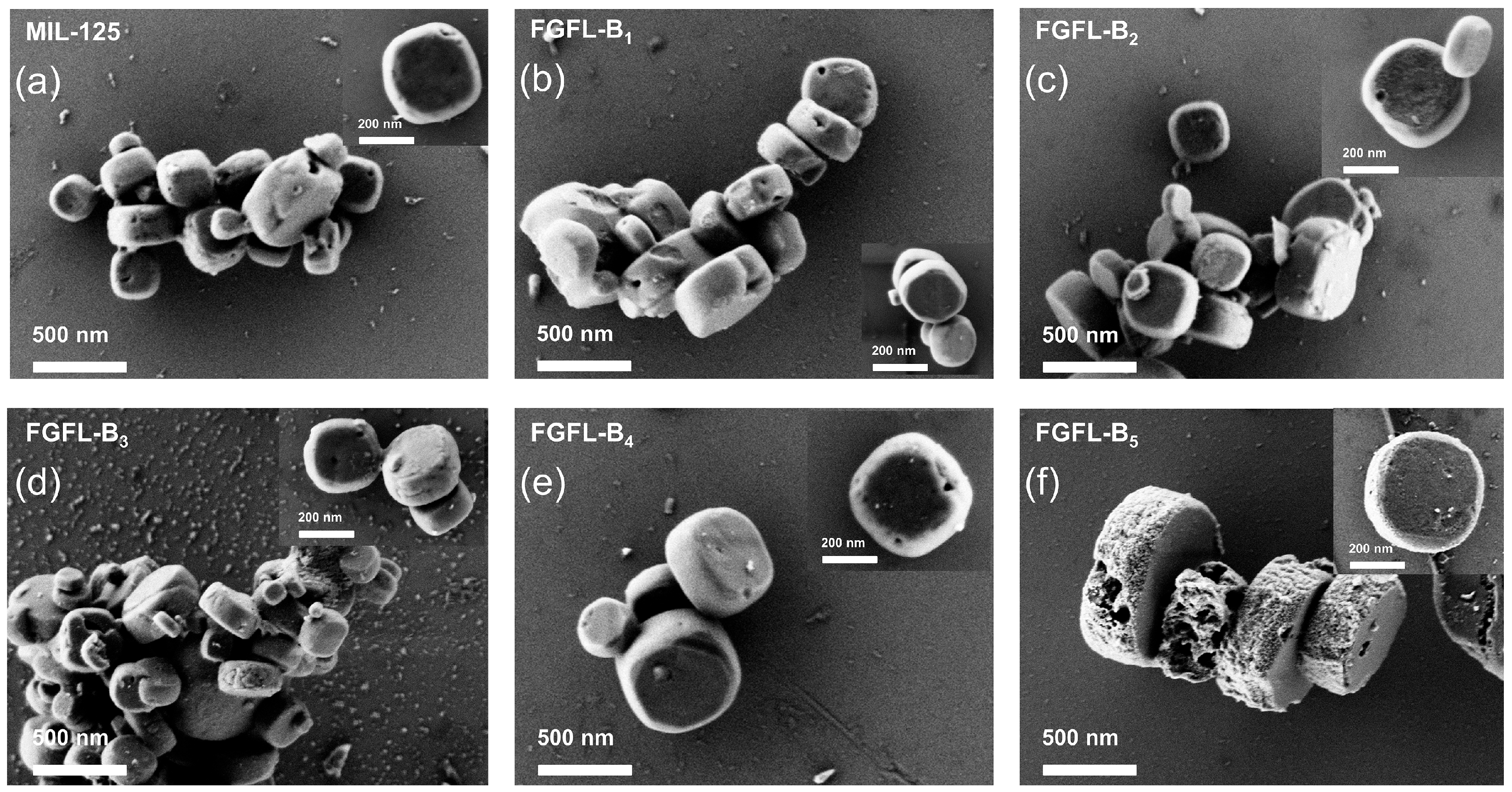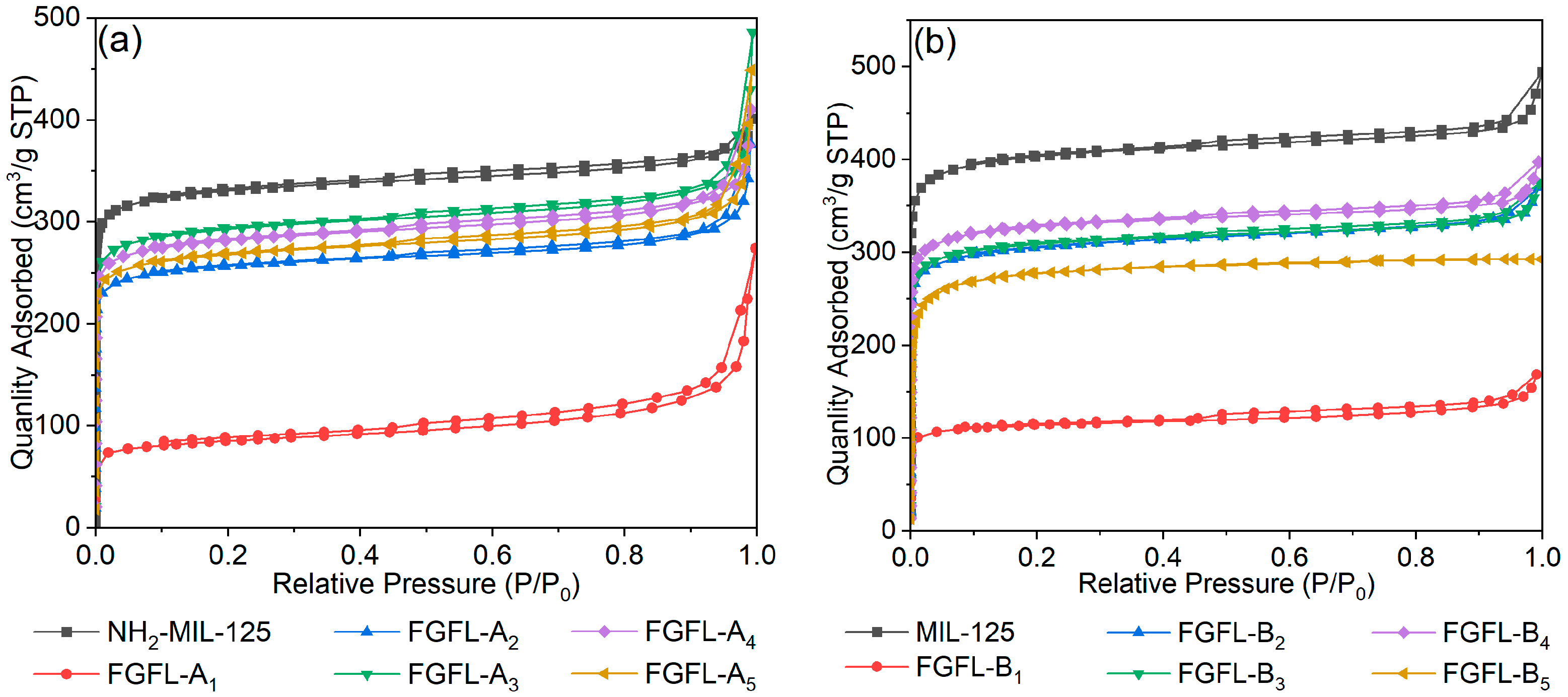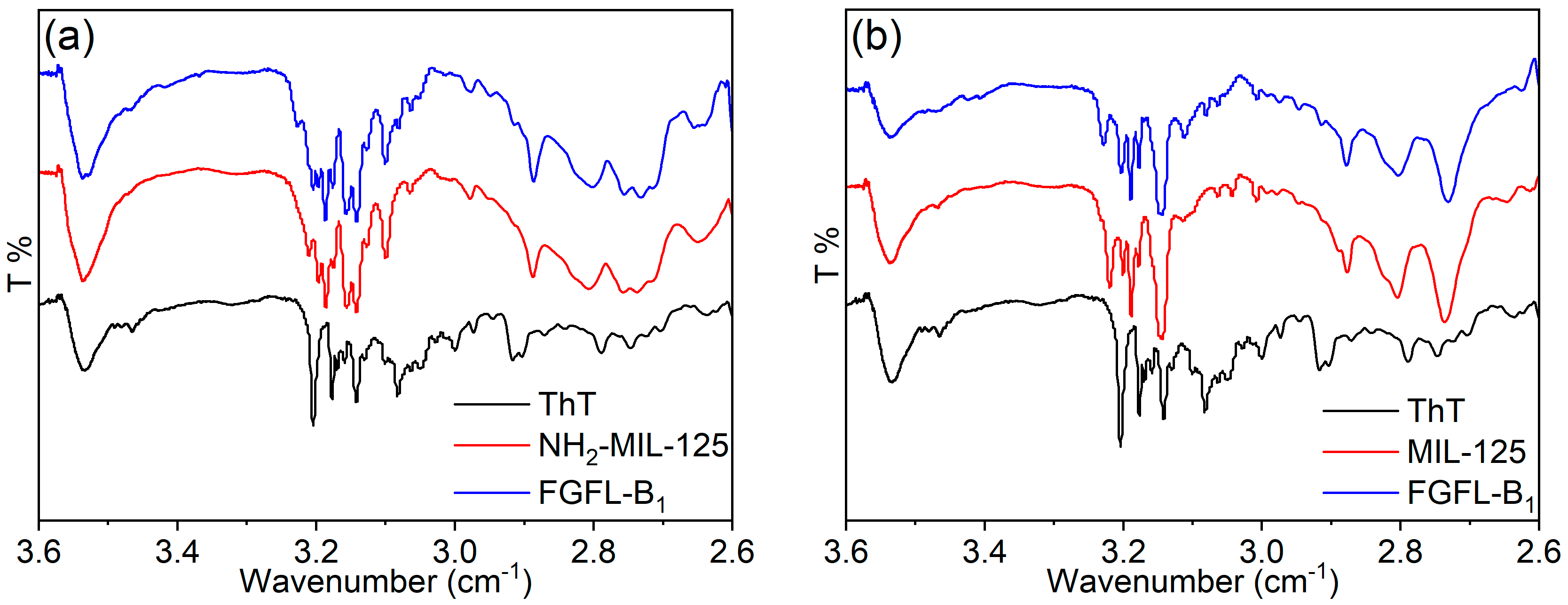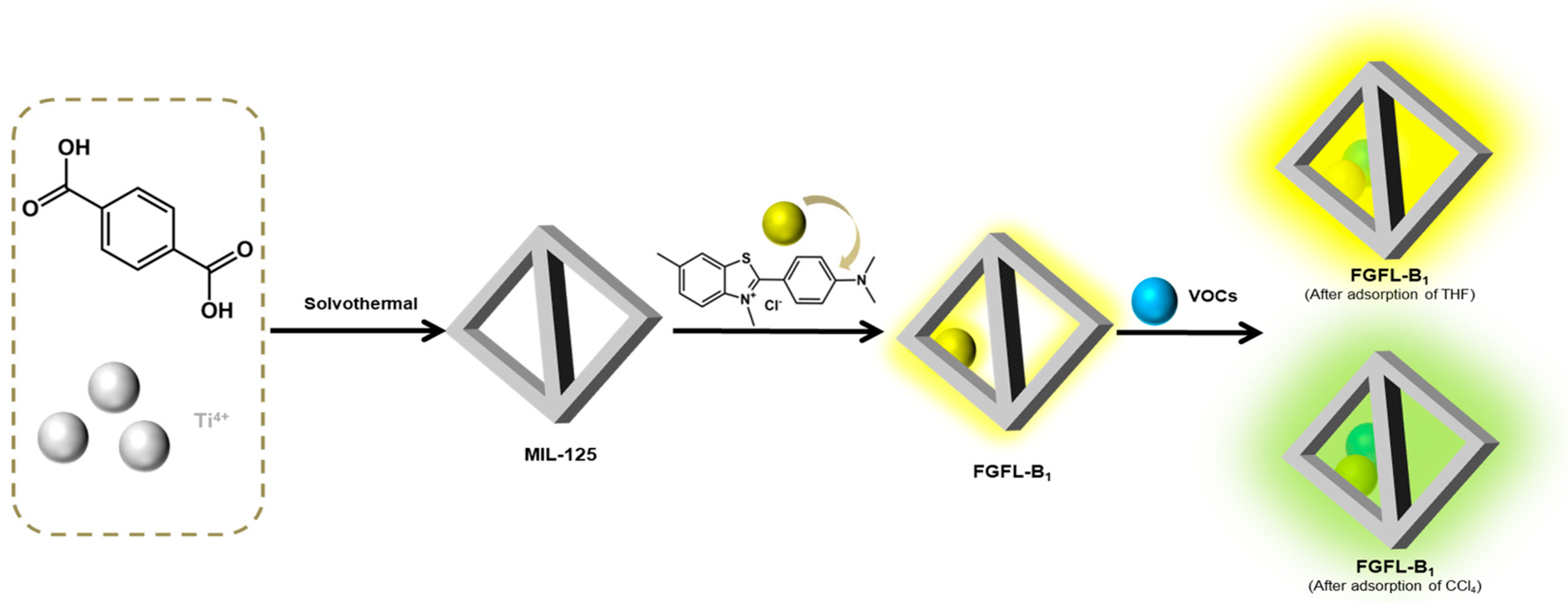Specific Recognition and Adsorption of Volatile Organic Compounds by Using MIL-125-Based Porous Fluorescence Probe Material
Abstract
:1. Introduction
2. Experimental
2.1. Materials
2.2. Methods
2.2.1. Precursor Synthesis
2.2.2. Porous Fluorescence Probe Synthesis
2.3. Adsorption and Fluorescence Response of FGFL-A1–5/FGFL-B1–5 for VOCs
2.4. Measurement of Fluorescence Spectra of Solid FGFL-A1–5/FGFL-B1–5
2.5. Characterization
3. Results and Discussion
3.1. Structure and Property of FGFL-A1–5/FGFL-B1–5
3.2. Fluorescence of FGFL-A1–5/FGFL-B1–5
3.3. Fluorescence Sensors and Storage Performance of VOCs over FGFL-B1
4. Conclusions
Supplementary Materials
Author Contributions
Funding
Data Availability Statement
Conflicts of Interest
References
- Pawelec, B.; Navarro, R.M.; Campos-Martin, J.M.; Fierro, J.L.G. Retracted Article: Towards near Zero-Sulfur Liquid Fuels: A Perspective Review. Catal. Sci. Technol. 2011, 1, 23–42. [Google Scholar] [CrossRef]
- Colvile, R.N.; Hutchinson, E.J.; Mindell, J.S.; Warren, R.F. The Transport Sector as a Source of Air Pollution. Atmos. Environ. 2001, 35, 1537–1565. [Google Scholar] [CrossRef]
- Guo, Y.; Wen, M.; Li, G.; An, T. Recent Advances in VOC Elimination by Catalytic Oxidation Technology onto Various Nanoparticles Catalysts: A Critical Review. Appl. Catal. B 2021, 281, 119447. [Google Scholar] [CrossRef]
- Zheng, J.-P.; Ou, S.; Zhao, M.; Wu, C.-D. A Highly Sensitive Luminescent Dye@MOF Composite for Probing Different Volatile Organic Compounds. ChemPlusChem 2016, 81, 758–763. [Google Scholar] [CrossRef]
- Hamon, L.; Serre, C.; Devic, T.; Loiseau, T.; Millange, F.; Férey, G.; Weireld, G.D. Comparative Study of Hydrogen Sulfide Adsorption in the MIL-53(Al, Cr, Fe), MIL-47(V), MIL-100(Cr), and MIL-101(Cr) Metal−Organic Frameworks at Room Temperature. J. Am. Chem. Soc. 2009, 131, 8775–8777. [Google Scholar] [CrossRef] [PubMed]
- Shi, J.; Zhao, Z.; Xia, Q.; Li, Y.; Li, Z. Adsorption and Diffusion of Ethyl Acetate on the Chromium-Based Metal–Organic Framework MIL-101. J. Chem. Eng. Data 2011, 56, 3419–3425. [Google Scholar] [CrossRef]
- Zhao, Z.; Li, X.; Li, Z. Adsorption Equilibrium and Kinetics of P-Xylene on Chromium-Based Metal Organic Framework MIL-101. Chem. Eng. J. 2011, 173, 150–157. [Google Scholar] [CrossRef]
- Pires, J.; Carvalho, A.; de Carvalho, M.B. Adsorption of Volatile Organic Compounds in Y Zeolites and Pillared Clays. Microporous Mesoporous Mater. 2001, 43, 277–287. [Google Scholar] [CrossRef]
- Chu, Y.-H.; Kim, H.-J.; Song, K.-Y.; Shul, Y.-G.; Jung, K.-T.; Lee, K.; Han, M.-H. Preparation of Mesoporous Silica Fiber Matrix for VOC Removal. Catal. Today 2002, 74, 249–256. [Google Scholar] [CrossRef]
- Liu, P.; Long, C.; Li, Q.; Qian, H.; Li, A.; Zhang, Q. Adsorption of Trichloroethylene and Benzene Vapors onto Hypercrosslinked Polymeric Resin. J. Hazard. Mater. 2009, 166, 46–51. [Google Scholar] [CrossRef]
- Ma, X.; Yang, L.; Wu, H. Removal of Volatile Organic Compounds from the Coal-Fired Flue Gas by Adsorption on Activated Carbon. J. Clean. Prod. 2021, 302, 126925. [Google Scholar] [CrossRef]
- Lee, K.J.; Miyawaki, J.; Shiratori, N.; Yoon, S.-H.; Jang, J. Toward an Effective Adsorbent for Polar Pollutants: Formaldehyde Adsorption by Activated Carbon. J. Hazard. Mater. 2013, 260, 82–88. [Google Scholar] [CrossRef] [PubMed]
- Lin, Y.; Massa, W.; Dehnen, S. “Zeoball” [Sn36Ge24Se132]24–: A Molecular Anion with Zeolite-Related Composition and Spherical Shape. J. Am. Chem. Soc. 2012, 134, 4497–4500. [Google Scholar] [CrossRef]
- Férey, G. Hybrid Porous Solids: Past, Present, Future. Chem. Soc. Rev. 2008, 37, 191–214. [Google Scholar] [CrossRef] [PubMed]
- Xiao, B.; Wheatley, P.S.; Zhao, X.; Fletcher, A.J.; Fox, S.; Rossi, A.G.; Megson, I.L.; Bordiga, S.; Regli, L.; Thomas, K.M.; et al. High-Capacity Hydrogen and Nitric Oxide Adsorption and Storage in a Metal−Organic Framework. J. Am. Chem. Soc. 2007, 129, 1203–1209. [Google Scholar] [CrossRef]
- Shen, Y.; Tissot, A.; Serre, C. Recent Progress on MOF-Based Optical Sensors for VOC Sensing. Chem. Sci. 2022, 13, 13978–14007. [Google Scholar] [CrossRef]
- Zhou, H.-C.; Kitagawa, S. (Eds.) Metal-Organic Frameworks (MOFs). Chem. Soc. Rev. 2014, 43, 5415–5418. [Google Scholar] [CrossRef]
- Long, J.R.; Yaghi, O.M. The Pervasive Chemistry of Metal-Organic Frameworks. Chem. Soc. Rev. 2009, 38, 1213–1214. [Google Scholar] [CrossRef]
- Zhou, H.-C.; Long, J.R.; Yaghi, O.M. Introduction to Metal-Organic Frameworks. Chem. Rev. 2012, 112, 673–674. [Google Scholar] [CrossRef]
- Lee, J.; Farha, O.K.; Roberts, J.; Scheidt, K.A.; Nguyen, S.T.; Hupp, J.T. Metal-Organic Framework Materials as Catalysts. Chem. Soc. Rev. 2009, 38, 1450–1459. [Google Scholar] [CrossRef]
- Tannert, N.; Sun, Y.; Hastürk, E.; Nießing, S.; Janiak, C. A Series of New Urea-MOFs Obtained via Post-Synthetic Modification of NH2-MIL-101(Cr): SO2, CO2 and H2O Sorption. Z. Für Anorg. Und Allg. Chem. 2021, 647, 1124–1130. [Google Scholar] [CrossRef]
- Suh, M.P.; Park, H.J.; Prasad, T.K.; Lim, D.-W. Hydrogen Storage in Metal-Organic Frameworks. Chem. Rev. 2012, 112, 782–835. [Google Scholar] [CrossRef]
- Ingleson, M.J.; Barrio, J.P.; Bacsa, J.; Dickinson, C.; Park, H.; Rosseinsky, M.J. Generation of a Solid Brønsted Acid Site in a Chiral Framework. Chem. Commun. 2008, 11, 1287–1289. [Google Scholar] [CrossRef] [PubMed]
- Kitagawa, S.; Kitaura, R.; Noro, S. Functional Porous Coordination Polymers. Angew. Chem. Int. Ed. Engl. 2004, 43, 2334–2375. [Google Scholar] [CrossRef] [PubMed]
- Mueller, U.; Schubert, M.; Teich, F.; Puetter, H.; Schierle-Arndt, K.; Pastré, J. Metal-Organic Frameworks-Prospective Industrial Applications. J. Mater. Chem. 2006, 16, 626–636. [Google Scholar] [CrossRef]
- Wang, M.; Guo, L.; Cao, D. Amino-Functionalized Luminescent Metal-Organic Framework Test Paper for Rapid and Selective Sensing of SO2 Gas and Its Derivatives by Luminescence Turn-On Effect. Anal. Chem. 2018, 90, 3608–3614. [Google Scholar] [CrossRef]
- Gan, L.; Andres-Garcia, E.; Mínguez Espallargas, G.; Planas, J.G. Adsorptive Separation of CO2 by a Hydrophobic Carborane-Based Metal-Organic Framework under Humid Conditions. ACS Appl. Mater. Interfaces 2023, 15, 5309–5316. [Google Scholar] [CrossRef]
- Li, Y.-A.; Zhao, C.-W.; Zhu, N.-X.; Liu, Q.-K.; Chen, G.-J.; Liu, J.-B.; Zhao, X.-D.; Ma, J.-P.; Zhang, S.; Dong, Y.-B. Nanoscale UiO-MOF-Based Luminescent Sensors for Highly Selective Detection of Cysteine and Glutathione and Their Application in Bioimaging. Chem. Commun. 2015, 51, 17672–17675. [Google Scholar] [CrossRef]
- Ke, F.; Yuan, Y.-P.; Qiu, L.-G.; Shen, Y.-H.; Xie, A.-J.; Zhu, J.-F.; Tian, X.-Y.; Zhang, L.-D. Facile Fabrication of Magnetic Metal-Organic Framework Nanocomposites for Potential Targeted Drug Delivery. J. Mater. Chem. 2011, 21, 3843–3848. [Google Scholar] [CrossRef]
- Hu, Z.; Deibert, B.J.; Li, J. Luminescent Metal-Organic Frameworks for Chemical Sensing and Explosive Detection. Chem. Soc. Rev. 2014, 43, 5815–5840. [Google Scholar] [CrossRef]
- Song, L.; Du, S.-W.; Lin, J.-D.; Zhou, H.; Li, T. A 3D Metal-Organic Framework with Rare 3-Fold Interpenetrating Dia-g Nets Based on Silver(I) and Novel Tetradentate Imidazolate Ligand: Synthesis, Structure, and Possible Ferroelectric Property. Cryst. Growth Des. 2007, 7, 2268–2271. [Google Scholar] [CrossRef]
- Du, J.-L.; Hu, T.-L.; Li, J.-R.; Zhang, S.-M.; Bu, X.-H. Metal Coordination Architectures of 2,3-Bis(Triazol-1-Ylmethyl)Quinoxaline: Effect of Metal Ion and Counterion on Complex Structures. Eur. J. Inorg. Chem. 2008, 2008, 1059–1066. [Google Scholar] [CrossRef]
- Wu, M.-M.; Wang, J.-Y.; Sun, R.; Zhao, C.; Zhao, J.-P.; Che, G.-B.; Liu, F.-C. The Design of Dual-Emissive Composite Material [Zn2(HL)3]+@MOF-5 as Self-Calibrating Luminescent Sensors of Al3+ Ions and Monoethanolamine. Inorg. Chem. 2017, 56, 9555–9562. [Google Scholar] [CrossRef]
- Geranmayeh, S.; Mohammadnejad, M.; Abbasi, A. Ln Based Metal-Organic Framework for Fluorescence “Turn Off-On” Sensing of Hg2+. J. Fluoresc. 2023, 33, 1017–1026. [Google Scholar] [CrossRef] [PubMed]
- Allendorf, M.D.; Bauer, C.A.; Bhakta, R.K.; Houk, R.J.T. Luminescent Metal-Organic Frameworks. Chem. Soc. Rev. 2009, 38, 1330–1352. [Google Scholar] [CrossRef] [PubMed]
- Dong, M.-J.; Zhao, M.; Ou, S.; Zou, C.; Wu, C.-D. A Luminescent Dye@MOF Platform: Emission Fingerprint Relationships of Volatile Organic Molecules. Angew. Chem. Int. Ed. 2014, 53, 1575–1579. [Google Scholar] [CrossRef]
- An, J.; Shade, C.M.; Chengelis-Czegan, D.A.; Petoud, S.; Rosi, N.L. Zinc-Adeninate Metal-Organic Framework for Aqueous Encapsulation and Sensitization of Near-Infrared and Visible Emitting Lanthanide Cations. J. Am. Chem. Soc. 2011, 133, 1220–1223. [Google Scholar] [CrossRef]
- Yao, Y.-Q.; Zhang, Y.-J.; Zhang, Y.-Q.; Tao, Z.; Ni, X.-L.; Wei, G. Multiple Efficient Fluorescence Emission from Cucurbit[10]Uril-[Cd4Cl16]8−-Based Pillared Diamond Porous Supramolecular Frameworks. ACS Appl. Mater. Interfaces 2017, 9, 40760–40765. [Google Scholar] [CrossRef]
- Tian, F.Y.; Cheng, R.X.; Zhang, Y.Q.; Tao, Z.; Zhu, Q.J. Specific Recognition of Methanol Using a Symmetric Tetramethylcucurbit[6]Uril-Based Porous Supramolecular Assembly Incorporating Adsorbed Dyes. Aust. J. Chem. 2020, 73, 1065. [Google Scholar] [CrossRef]
- Dan-Hardi, M.; Serre, C.; Frot, T.; Rozes, L.; Maurin, G.; Sanchez, C.; Férey, G. A New Photoactive Crystalline Highly Porous Titanium(IV) Dicarboxylate. J. Am. Chem. Soc. 2009, 131, 10857–10859. [Google Scholar] [CrossRef]
- Kim, S.-N.; Kim, J.; Kim, H.-Y.; Cho, H.-Y.; Ahn, W.-S. Adsorption/Catalytic Properties of MIL-125 and NH2-MIL-125. Catal. Today 2013, 204, 85–93. [Google Scholar] [CrossRef]
- Kim, B.; Lee, Y.-R.; Kim, H.-Y.; Ahn, W.-S. Adsorption of Volatile Organic Compounds over MIL-125-NH2. Polyhedron 2018, 154, 343–349. [Google Scholar] [CrossRef]
- Fu, Y.; Sun, D.; Chen, Y.; Huang, R.; Ding, Z.; Fu, X.; Li, Z. An Amine-Functionalized Titanium Meta-Organic Framework Photocatalyst with Visible-Light-Induced Activity for CO2 Reduction. Angew. Chem. Int. Ed. 2012, 51, 3364–3367. [Google Scholar] [CrossRef] [PubMed]
- Cui, Y.; Yue, Y.; Qian, G.; Chen, B. Luminescent Functional Metal-Organic Frameworks. Chem. Rev. 2012, 112, 1126–1162. [Google Scholar] [CrossRef]
- Sjekloća, L.; Ferré-D’Amaré, A.R. Binding between G Quadruplexes at the Homodimer Interface of the Corn RNA Aptamer Strongly Activates Thioflavin T Fluorescence. Cell Chem. Biol. 2019, 26, 1159–1168.e4. [Google Scholar] [CrossRef]
- Mohanty, J.; Choudhury, S.D.; Pal, H.; Bhasikuttan, A.C. Early Detection of Insulin Fibrillation: A Fluorescence Lifetime Assay to Probe the Pre-Fibrillar Regime. Chem. Commun. 2012, 48, 2403–2405. [Google Scholar] [CrossRef]
- Nielsen, L.; Khurana, R.; Coats, A.; Frokjaer, S.; Brange, J.; Vyas, S.; Uversky, V.N.; Fink, A.L. Effect of Environmental Factors on the Kinetics of Insulin Fibril Formation: Elucidation of the Molecular Mechanism. Biochemistry 2001, 40, 6036–6046. [Google Scholar] [CrossRef]
- Mei, J.; Leung, N.L.C.; Kwok, R.T.K.; Lam, J.W.Y.; Tang, B.Z. Aggregation-Induced Emission: Together We Shine, United We Soar! Chem. Rev. 2015, 115, 11718–11940. [Google Scholar] [CrossRef]
- Liu, J.; Meng, Q.; Zhang, X.; Lu, X.; He, P.; Jiang, L.; Dong, H.; Hu, W. Aggregation-Induced Emission Enhancement Based on 11,11,12,12,-Tetracyano-9,10-Anthraquinodimethane. Chem. Commun. 2013, 49, 1199–1201. [Google Scholar] [CrossRef]
- He, J.; Xu, B.; Chen, F.; Xia, H.; Li, K.; Ye, L.; Tian, W. Aggregation-Induced Emission in the Crystals of 9,10-Distyrylanthracene Derivatives: The Essential Role of Restricted Intramolecular Torsion. J. Phys. Chem. C 2009, 113, 9892–9899. [Google Scholar] [CrossRef]
- Krebs, F.C.; Spanggaard, H. An Exceptional Red Shift of Emission Maxima upon Fluorine Substitution. J. Org. Chem. 2002, 67, 7185–7192. [Google Scholar] [CrossRef] [PubMed]
- Choudhury, S.D.; Mohanty, J.; Pal, H.; Bhasikuttan, A.C. Cooperative Metal Ion Binding to a Cucurbit[7]Uril−Thioflavin T Complex: Demonstration of a Stimulus-Responsive Fluorescent Supramolecular Capsule. J. Am. Chem. Soc. 2010, 132, 1395–1401. [Google Scholar] [CrossRef] [PubMed]
- Solís, R.R.; Gómez-Avilés, A.; Belver, C.; Rodriguez, J.J.; Bedia, J. Microwave-Assisted Synthesis of NH2-MIL-125(Ti) for the Solar Photocatalytic Degradation of Aqueous Emerging Pollutants in Batch and Continuous Tests. J. Environ. Chem. Eng. 2021, 9, 106230. [Google Scholar] [CrossRef]
- Vandenbroucke, A.M.; Morent, R.; De Geyter, N.; Leys, C. Non-Thermal Plasmas for Non-Catalytic and Catalytic VOC Abatement. J. Hazard. Mater. 2011, 195, 30–54. [Google Scholar] [CrossRef]
- Guieysse, B.; Hort, C.; Platel, V.; Munoz, R.; Ondarts, M.; Revah, S. Biological Treatment of Indoor Air for VOC Removal: Potential and Challenges. Biotechnol. Adv. 2008, 26, 398–410. [Google Scholar] [CrossRef] [PubMed]
- Manos, M.J.; Malliakas, C.D.; Kanatzidis, M.G. Heavy-Metal-Ion Capture, Ion-Exchange, and Exceptional Acid Stability of the Open-Framework Chalcogenide (NH4)4In12Se20. Chem. Eur. J. 2007, 13, 51–58. [Google Scholar] [CrossRef]
- Moody, D.E. The Effect of Tetrahydrofuran on Biological Systems: Does a Hepatotoxic Potential Exist. Drug Chem. Toxicol. 1991, 14, 319–342. [Google Scholar] [CrossRef]
- Draper, A.J.; Madan, A.; Parkinson, A. Inhibition of Coumarin 7-Hydroxylase Activity in Human Liver Microsomes. Arch. Biochem. Biophys. 1997, 341, 47–61. [Google Scholar] [CrossRef]
- Fan, H.; Tu, T.; Zhang, X.; Yang, Q.; Liu, G.; Zhang, T.; Bao, Y.; Lu, Y.; Dong, Z.; Dong, J.; et al. Sinomenine Attenuates Alcohol-Induced Acute Liver Injury via Inhibiting Oxidative Stress, Inflammation and Apoptosis in Mice. Food Chem. Toxicol. 2022, 159, 112759. [Google Scholar] [CrossRef]
- Biancalana, M.; Koide, S. Molecular Mechanism of Thioflavin-T Binding to Amyloid Fibrils. Biochim. Et Biophys. Acta (BBA) Proteins Proteom. 2010, 1804, 1405–1412. [Google Scholar] [CrossRef]
- Harel, M.; Sonoda, L.K.; Silman, I.; Sussman, J.L.; Rosenberry, T.L. Crystal Structure of Thioflavin T Bound to the Peripheral Site of Torpedo Californica Acetylcholinesterase Reveals How Thioflavin T Acts as a Sensitive Fluorescent Reporter of Ligand Binding to the Acylation Site. J. Am. Chem. Soc. 2008, 130, 7856–7861. [Google Scholar] [CrossRef] [PubMed]
- Takashima, Y.; Martínez, V.M.; Furukawa, S.; Kondo, M.; Shimomura, S.; Uehara, H.; Nakahama, M.; Sugimoto, K.; Kitagawa, S. Molecular Decoding Using Luminescence from an Entangled Porous Framework. Nat. Commun. 2011, 2, 168. [Google Scholar] [CrossRef]
- Fang, M.-M.; Yang, J.; Li, Z. Recent Advances in Purely Organic Room Temperature Phosphorescence Polymer. Chin. J. Polym. Sci. 2019, 37, 383–393. [Google Scholar] [CrossRef]
- Wang, Y.; Yang, J.; Tian, Y.; Fang, M.; Liao, Q.; Wang, L.; Hu, W.; Tang, B.Z.; Li, Z. Persistent Organic Room Temperature Phosphorescence: What Is the Role of Molecular Dimers? Chem. Sci. 2020, 11, 833–838. [Google Scholar] [CrossRef]
- Xie, Y.; Li, Z. The Development of Mechanoluminescence from Organic Compounds: Breakthrough and Deep Insight. Mater. Chem. Front. 2020, 4, 317–331. [Google Scholar] [CrossRef]
- Liu, Y.; Xiao, X.; Ran, Y.; Bin, Z.; You, J. Molecular Design of Thermally Activated Delayed Fluorescent Emitters for Narrowband Orange–Red OLEDs Boosted by a Cyano-Functionalization Strategy. Chem. Sci. 2021, 12, 9408–9412. [Google Scholar] [CrossRef] [PubMed]
- Chakraborty, S.; Bhattacharjee, D.; Hussain, S.A. Formation of Nanoscale Aggregates of a Coumarin Derivative in Langmuir-Blodgett Film. Appl. Phys. A 2013, 111, 1037–1043. [Google Scholar] [CrossRef]
- Yang, J.; Huang, J.; Li, Q.; Li, Z. Blue AIEgens: Approaches to Control the Intramolecular Conjugation and the Optimized Performance of OLED Devices. J. Mater. Chem. C 2016, 4, 2663–2684. [Google Scholar] [CrossRef]








Disclaimer/Publisher’s Note: The statements, opinions and data contained in all publications are solely those of the individual author(s) and contributor(s) and not of MDPI and/or the editor(s). MDPI and/or the editor(s) disclaim responsibility for any injury to people or property resulting from any ideas, methods, instructions or products referred to in the content. |
© 2023 by the authors. Licensee MDPI, Basel, Switzerland. This article is an open access article distributed under the terms and conditions of the Creative Commons Attribution (CC BY) license (https://creativecommons.org/licenses/by/4.0/).
Share and Cite
Wu, Q.; Tian, F.; Chen, W.; Wang, J.; Lei, B. Specific Recognition and Adsorption of Volatile Organic Compounds by Using MIL-125-Based Porous Fluorescence Probe Material. Nanomaterials 2023, 13, 2732. https://doi.org/10.3390/nano13192732
Wu Q, Tian F, Chen W, Wang J, Lei B. Specific Recognition and Adsorption of Volatile Organic Compounds by Using MIL-125-Based Porous Fluorescence Probe Material. Nanomaterials. 2023; 13(19):2732. https://doi.org/10.3390/nano13192732
Chicago/Turabian StyleWu, Qiuyu, Feiyang Tian, Wenqian Chen, Jianying Wang, and Bo Lei. 2023. "Specific Recognition and Adsorption of Volatile Organic Compounds by Using MIL-125-Based Porous Fluorescence Probe Material" Nanomaterials 13, no. 19: 2732. https://doi.org/10.3390/nano13192732
APA StyleWu, Q., Tian, F., Chen, W., Wang, J., & Lei, B. (2023). Specific Recognition and Adsorption of Volatile Organic Compounds by Using MIL-125-Based Porous Fluorescence Probe Material. Nanomaterials, 13(19), 2732. https://doi.org/10.3390/nano13192732





